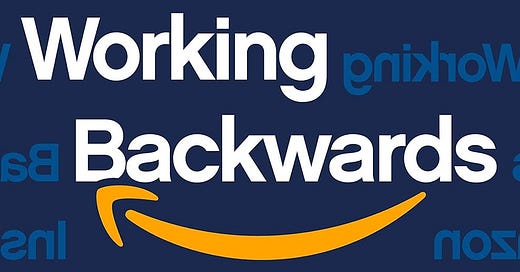CX Book Gems #26: Working Backwards
Book summary of "Working Backwards: Insights, Stories, and Secrets from Inside Amazon" by Colin Bryar and Bill Carr.
Today’s newsletter feature is Working Backwards: Insights, Stories, and Secrets from Inside Amazon by Colin Bryar and Bill Carr.
📘 Book Summary
Amazon is one of the most influential and customer-obsessed companies in the world. In Working Backwards, former Amazon executives Colin Bryar and Bill Carr provide an inside look into the company’s culture, leadership principles, and operational strategies. The book details how Amazon scaled from a small online bookstore to a global tech giant by implementing innovative decision-making processes, focusing on customer needs, and maintaining a long-term vision. It introduces key frameworks like the Working Backwards process and Amazon’s Leadership Principles—tools that can be applied to any business looking to drive innovation, customer focus, and sustained growth.
Most of Amazon’s major products and initiatives since 2004 have one very Amazonian thing in common — they were created through a process called Working Backwards.
💎 4 CX Gems
1. The “Working Backwards” process ensures customer-centric innovation
Instead of starting with a product idea and figuring out how to sell it, Amazon’s Working Backwards method requires teams to define the ideal customer experience first and then develop the product to meet that vision. This process includes writing an internal press release (PR) that clearly describes the customer problem, the solution, and its benefits before any development begins. Teams also create a Frequently Asked Questions (FAQ) document to address potential challenges and ensure alignment with customer needs.
2. Leadership principles drive decision-making and culture
Amazon’s 16 Leadership Principles guide decision-making across all levels of the organization. Principles like "Customer Obsession," "Bias for Action," and "Insist on the Highest Standards" shape how employees operate and innovate. These principles empower employees to take ownership, make data-driven decisions, and challenge conventional thinking to continuously improve.
Customer Obsession
Ownership
Invent and Simplify
Are Right, A Lot
Learn and Be Curious
Hire and Develop the Best
Insist on the Highest Standards
Think Big
Bias for Action
Frugality
Earn Trust
Dive Deep
Have Backbone; Disagree and Commit
Deliver Results
Strive to be Earth’s Best Employer
Success and Scale Bring Broad Responsibility
If a company’s principles must be memorized, it’s a warning sign that they aren’t sufficiently woven into the fabric of that company.
3. High-velocity decision-making accelerates growth
Amazon classifies decisions into Type 1 (irreversible, high-stakes) and Type 2 (reversible, low-stakes). By distinguishing between the two, Amazon ensures that high-impact decisions are made carefully, while lower-risk decisions can be made quickly to foster agility and experimentation. This model reduces bottlenecks and allows the company to scale rapidly while maintaining flexibility.
4. Hiring for long-term excellence
Amazon eliminates urgency and confirmation bias from its hiring process by implementing the "bar-raiser" system—experienced interviewers with no vested interest in filling the role quickly. This ensures only the best candidates are hired and maintains a high-performance culture. Additionally, Amazon prevents confirmation bias by requiring interviewers to write detailed reports before discussing candidates, ensuring objective hiring decisions.
✅ 4 Quickstart Tips
Before launching a new initiative, write a press release from the customer’s perspective to clarify the problem and the value your solution provides.
Establish clear leadership principles for your team or organization, ensuring that every decision aligns with customer needs and long-term goals.
Identify whether a decision is Type 1 or Type 2 before acting. Empower teams to make Type 2 decisions quickly to maintain momentum.
Instead of rushing to fill positions, implement structured hiring processes like Amazon’s bar-raiser system.
Working Backwards offers a deep dive into Amazon’s relentless focus on customers, innovative problem-solving frameworks, and high-performance culture. The strategies detailed in the book—like the Working Backwards process and Leadership Principles—provide a roadmap for businesses looking to build customer-obsessed, scalable, and innovative organizations. By applying these principles, leaders can drive long-term success while maintaining a relentless focus on delivering value to customers.



